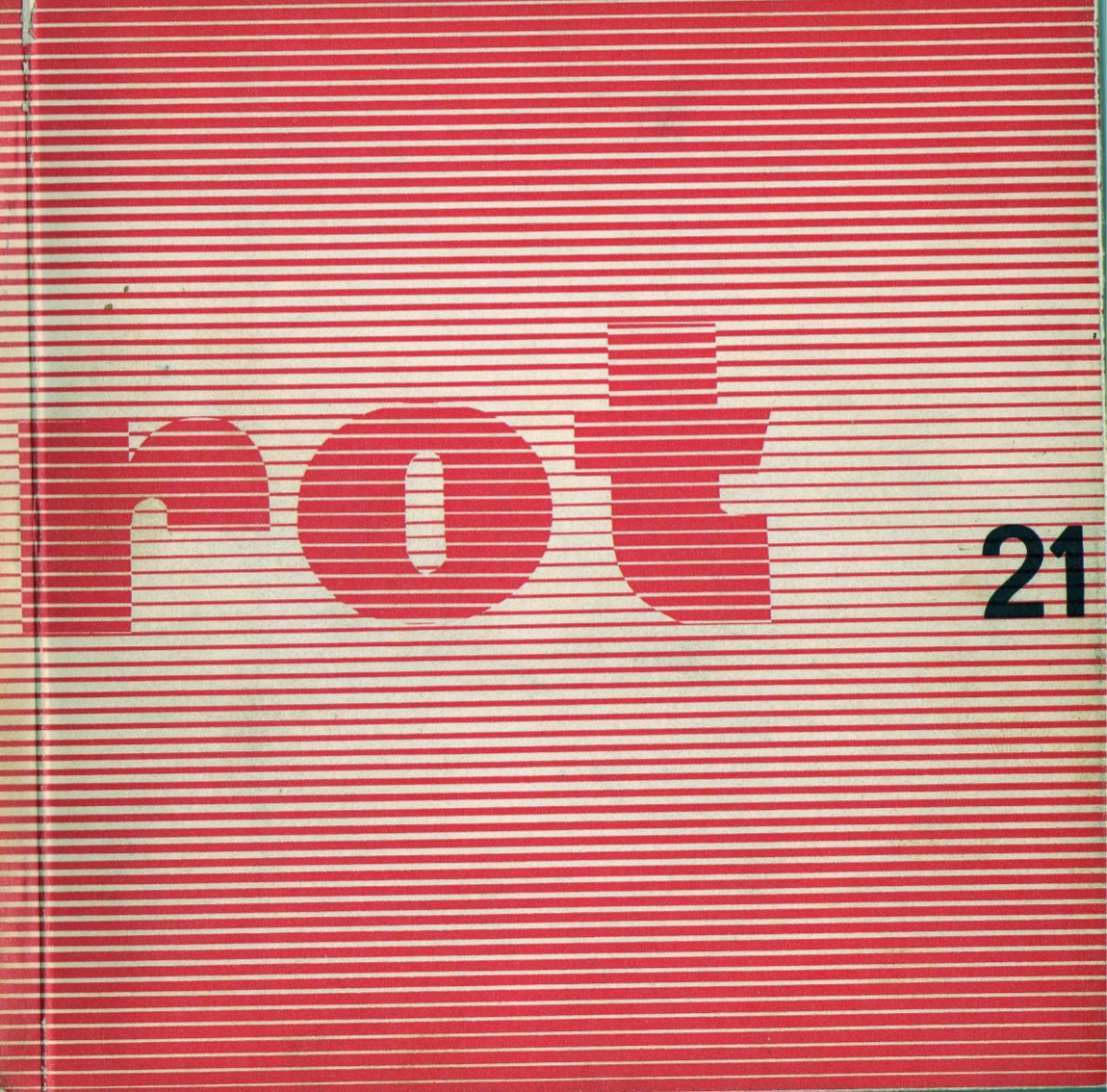Max Bense, Elisabeth Walther (eds.): rot 21: konkrete poesie international (1965)
Filed under book, magazine | Tags: · concrete poetry, poetry, visual poetry

An anthology of concrete poetry. Special issue of rot.
Works by diter rot, edwin morgan, ian hamilton finlay, vagn steen, emmet williams, peter greenham, ladislaw novák, josef hirsal und bohumila grögerová, paul de vree, pierre garnier, john j. sharkey, dom sylvester houédard, yüksel pazarkaya, mathias goeritz, carlo belloli, eugen gomringer, gerhard rühm, ernst jandl, kurt sanmark, åke hodell, leif nylén, hans-jørgen nielsen, jörgen nash, augusto de campos, ronaldo azeredo, haroldo de campos, josé lino grünewald, franz mon, décio pignatari, reinhard döhl, timm ulrichs, konrad balder schäuffelen, edgar braga, pedro xisto, claus bremer, helmut heißenbüttel.
With an Afterword by Max Bense
Published in Stuttgart, May 1965
Cover design Walter Faigle
Printing Hansjörg Mayer
ISBN 3874510212
[46] pages
via Archivio Maurizio Spatola
PDF (10 MB)
Comment (1)Max Bense: aesthetica IV. Programmierung des Schönen. Allgemeine Texttheorie und Textästhetik (1960) [German]
Filed under book | Tags: · aesthetics, information theory, literary theory, statistics, text, theory

“Max Benses informationeile Ästhetik schließt mit einer Allgemeinen Texttheorie ab, die, auf der Grundlage statistischer Untersuchungen von Fucks, Herdan, Mandelbrot u. a., als Modell der neuen statistischen Zeichen-Ästhetik aufgefaßt werden kann.
Die Allgemeine Texttheorie bezieht sich auf jede Art von Text, schließt also die ästhetische Theorie der Poesie und Prosa, aber auch der wissenschaftlichen Sprachen, Werbesprachen und abstrakten Sprachen usw. ein.
Der Begriff Text wird dabei als derjenige sprachliche Zustand aufgefaßt, der statistische bzw. informationelle, semantische bzw. ästhetische Formen meint, aus deren Materialität Poesie und Prosa im klassischen Sinne erst hervorgehen. Der Begriff Text zielt also nicht auf vorästhetische Zustände der Sprache ab, sondern auf vorpoetische und vorprosaische. Er bestimmt gewissermaßen die archaischen theoretischen Fundamente der Literatur.
Allgemeine Texttheorie umfaßt also Textstatistik, Textsemantik, Textphänomenologie und Textästhetik. Der bisher völlig unklar oder falsch verwendete Ausdruck Logik der Dichtung verschwindet zugunsten des genau formulierbaren Ausdrucks Textsemantik, der den Begriff Textlogik mit umfaßt.
Es werden also sowohl numerische wie essentielle Überlegungen zum Begriff Text angestellt.
Die Allgemeine Texttheorie erscheint als Grundlagenforschung für zukünftige Literaturwissenschaft und Literaturtheorie. Sie will exakte Mittel einführen und der beliebigen üblichen Interpretation, soweit sie nicht historische Fakten herausstellt, ein Ende bereiten.” (from the dusk jacket)
Publisher Agis, Baden-Baden and Krefeld, 1960
128 pages
via Mitchell Johnson
Commentary: Reinhard Döhl (n.d., DE).
Comment (1)Max Bense, Elisabeth Walther (eds.): rot 19: Computer-Grafik (1968) [German]
Filed under booklet | Tags: · aesthetics, computer art, computer graphics

“This little booklet of 14 pages is one of the first publications ever on computer art. It appeared at the occasion of the first exhibition of computer-generated, algorithmic art world-wide: the famous show of a small set of graphic works by Georg Nees. The show was held from February 5 to 19, 1965, on the premises of the Studiengalerie of TH Stuttgart (now University of Stuttgart).
The booklet is in German. It contains two short contributions by Georg Nees (2 pages) and Max Bense (3 pages) plus six images of Nees’ earliest works.
Both texts are important from a historic perspective. Nees gives a brief account of the essentials of early algorithmic art, including five descriptions of programs in plain language. These descriptions are precise formulations of the algorithms, and as such they constitute perfect documentations, independent of programming language, operating system, run-time support, or hardware. This was possible because of the simplicity of the algorithmic schema.
Bense’s text, Projekte generativer Ästhetik, must be considered the manifesto of computer art. It introduces the notion of Generative Aesthetics, in direct reference to Chomsky’s Generative Grammar. It is formulated in Bense’s typical apodictic, rigorous, almost mechanistic prose. But it points to a development that started to blossom and gained recognition only during the first decade of the 21st century: the exciting movement of generative art, design, architecture, music, and more.
The special issue of Studio International, published by Jasia Reichardt, for the Cybernetic Serendipity exhibition in London, 1968, contains an English translation. It has often been re-published.” (source)
Published in Stuttgart, February 1965
14 pages
via Nina Wenhart
More information (compArt database Digital Art)
PDF (updated on 2016-2-17)
Comment (0)
